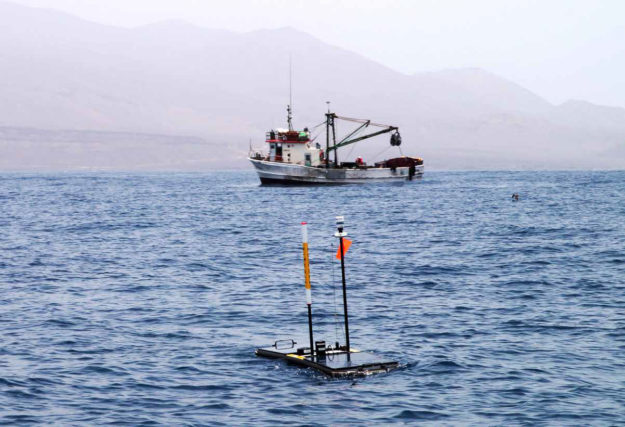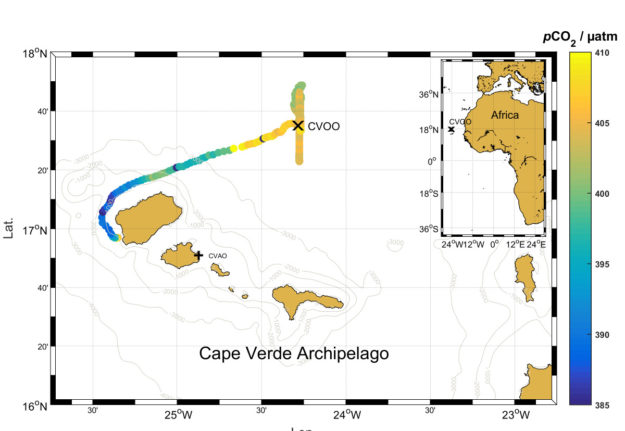Customer
GEOMAR Helmholtz Centre for Ocean Research Kiel
Mission Location
Cape Verde Archipelago
Highlights
- Continuously collected data on the exchange of CO2, O2 and N2 at the air/sea boundary
- Demonstrated the long-term stability of the measurements in the tropical Atlantic
- Increased the spatial and temporal coverage of observations
“We want to increase the spatial and temporal coverage of our observations with respect to the CO2 and O2 gas exchange between ocean and atmosphere. The Wave Glider, unmanned vehicle, is an ideal opportunity to close gaps in our measurements.”
The Challenge
Off the coast of Western Africa, you’ll find scientists from GEOMAR Helmholtz Centre for Ocean Research Kiel at the Cape Verde Ocean Observatory (CVOO) researching the structure of the marine ecosystem and the effects of biogeochemical processes in the oceans. Their mission is to observe, measure and monitor the climate-relevant environmental parameters at the ocean’s surface, the air/sea boundary. Their goal is to better understand the impact of global climate change on marine ecosystems.
One of the biggest challenges facing the scientists was to find a cost-e ective and reliable data collection platform for extended missions in remote, infrastructure-poor and under-sampled regions of the Atlantic. For countries less developed who can’t a ord to operate sophisticated research vessels or acquire innovative data collection technologies, this is a formidable barrier to understanding the health of their oceans and coastlines and to sustainable management of their marine resources.
The Approach
Looking for a creative alternative, Dr. Björn Fiedler, one of CVOO’s research scientists, turned to autonomous platforms for his biomass, CO2 and O2 time-series observations. He needed a flexible system that could easily adapt to specific applications/needs and could be viewed as a cost-efficient “mini” research vessel. His goals were to:
- Combine biogeochemical surveys with other ecosystem features such as biomass (fish, plankton) distributions;
- Measure the exchange of carbon dioxide gas at the air/sea boundary;
- Increase the spatial and temporal coverage of observations with respect to surface ocean biogeochemistry and biomass distributions.

The Wave Glider measuring CO2 and O2 exchange at the air/sea boundary in the Cape Verde Archipelago. Image courtesy of GEOMAR.
The Results
Working with Liquid Robotics, the Wave Glider was equipped with a biogeochemical (flow-through) sensor package, weather station, hull-mounted CTD, and echosounder. Field feasibility tests began off the West coast of Africa in the Cape Verde Archipelago. Over a period of three weeks, the Wave Glider continuously collected data on the exchange of CO2, O2 and N2 between the ocean and the atmosphere and successfully demonstrated the long-term stability of the measurements in the tropical Atlantic. High resolution observations revealed a surprisingly high variability of these parameters which may have been overlooked in the past due to a lack of observations.

Continuous CO2 partial pressure (pCO2) measurements at a depth of 0.3 m conducted by GEOMAR’s Wave Glider in May 2015. The Wave Glider traveled from the leeward side of the islands to the open-ocean CVOO site 60 nautical miles NE and performed various meridional sections.
What’s Next?
Building on this success, the next missions will focus on establishing Wave Glider operations on a regular basis in Western Africa and thereby enhancing spatio-temporal observations with respect to the CO2 and O2 gas exchange between ocean and atmosphere. Dr. Fiedler has expanded his research to add a 200 kHz Echosounder on the Wave Glider for conducting autonomous biomass surveys around Cape Verde. Results from these surveys will help local authorities to better manage their marine resources in a sustainable way. Early results have already produced excellent results.
 We have always been dependent on the availability of research vessels for our measurements. With the Wave Glider we are now able to carry out our research more flexibly and cost effectively.”
We have always been dependent on the availability of research vessels for our measurements. With the Wave Glider we are now able to carry out our research more flexibly and cost effectively.”